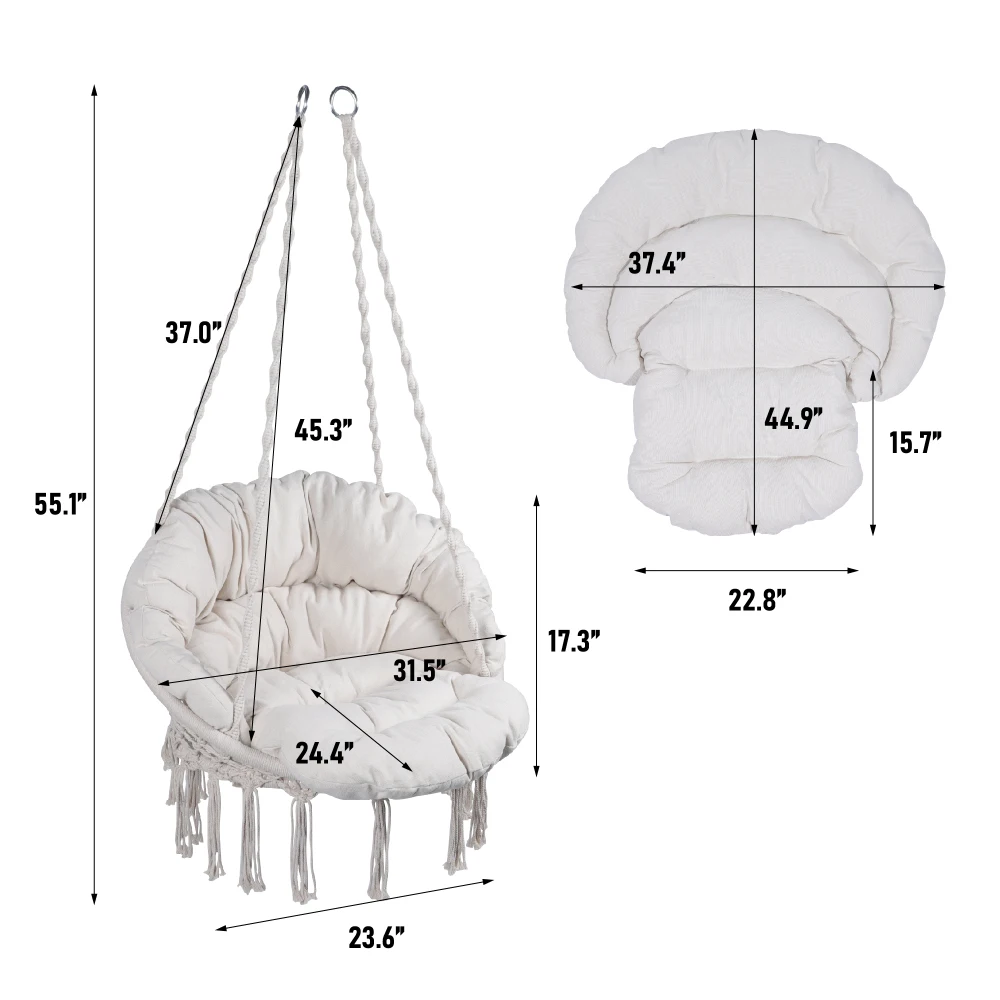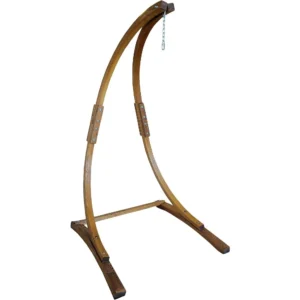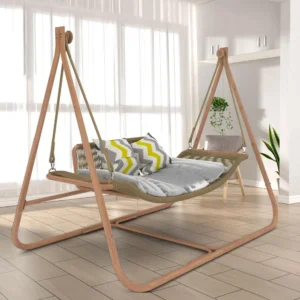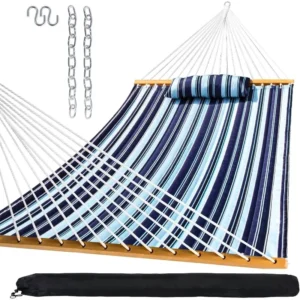The Short Answer: Yes, But with Important Limitations
Yes, you can technically sleep in a hammock chair, but there are significant limitations to consider before you try. Unlike traditional hammocks designed for lying down horizontally, hammock chairs are primarily designed for sitting upright or in a semi-reclined position.
While hammock chairs can be wonderful for relaxation and short naps, they present several challenges for extended or overnight sleep:
- Limited horizontal space restricts natural sleeping positions
- The seated design can cause pressure points and discomfort over time
- Neck and back support is often inadequate for proper sleep posture
- The semi-upright position may interfere with achieving deep, restorative sleep
At Outside Luxe, we’ve examined how different hammock designs affect comfort during both short and extended rest periods. Understanding the differences between deep seat hammocks for lounging and those designed for sleeping is crucial for making informed decisions about your relaxation needs.
Understanding Hammock Chair Design and Its Sleep Implications
The Structural Challenge
Hammock chairs feature a distinctive design that significantly impacts their suitability for sleeping:
- Single-point suspension system: Unlike traditional hammocks with two anchor points, most hammock chairs hang from a single overhead point, naturally creating a more upright sitting position.
- Concentrated weight distribution: Your body weight focuses primarily on your buttocks and lower back rather than being evenly distributed.
- Limited horizontal space: Traditional hammock chairs typically offer 2-3 feet of width, much less than the 4-7 feet provided by conventional hammocks.
Impact on Sleep Positioning
The physical design of hammock chairs forces your body into positions that aren’t ideal for extended sleep:
- The natural sitting position creates a C-curve in your spine rather than maintaining proper alignment
- Limited space restricts your ability to change positions during sleep, which can lead to stiffness
- Your head and neck often lack proper support unless additional pillows are used
- Legs are typically bent rather than extended, potentially affecting circulation
The semi-upright position may be fine for a quick nap but becomes problematic for achieving the deeper sleep stages your body needs for true rest and recovery. Our hammock chairs with stands are engineered for maximum comfort during relaxation, but even the best designs have limitations when it comes to overnight sleep.
Benefits of Short Naps in Hammock Chairs
Despite the limitations for extended sleep, hammock chairs offer several advantages for short naps and rest periods:
- Gentle rocking motion: The subtle swaying can help induce relaxation more quickly than stationary furniture, potentially helping you drift off for a quick nap.
- Cocoon-like environment: The enveloping fabric creates a sense of security that many find comforting and conducive to relaxation.
- Upright positioning benefits: The semi-reclined position may benefit those with certain digestive issues or acid reflux who need to keep their upper body elevated.
- Space efficiency: Hammock chairs require minimal floor space compared to beds or couches, making them ideal for small living areas.
- Accessibility: Having a dedicated relaxation spot encourages more frequent rest breaks throughout the day.
- Stress reduction: The gentle swaying motion can trigger a natural calming response in many people.
These benefits make hammock chairs excellent for afternoon reading sessions that turn into brief naps or intentional 15-20 minute power naps. Learning techniques for mastering deep seat hammock relaxation can enhance your comfort during these shorter rest periods.
Health Considerations: Why Hammock Chairs Aren’t Ideal for Extended Sleep
While short naps in hammock chairs can be pleasant, several health concerns emerge when considering longer sleep sessions:
Musculoskeletal Issues
- Neck strain: Without proper support, your head may fall forward or to the side during sleep, causing neck pain
- Lower back stress: The seated position places continuous pressure on your lumbar region
- Shoulder compression: The narrow width can force shoulders inward, potentially causing discomfort
Circulation Concerns
- Pressure points: Sitting positions concentrate weight on specific areas, potentially causing numbness
- Leg position: Dangling or bent legs can restrict blood flow over time
- Limited movement: Restricted ability to change positions naturally during sleep can reduce circulation
Sleep Quality Implications
- Sleep cycle disruption: The upright position may prevent achieving deeper sleep stages
- Increased awakenings: Discomfort typically leads to more frequent waking
- Reduced REM sleep: The physical limitations may prevent the full relaxation needed for REM sleep
Safety Considerations
- Balance issues: Movement during sleep could cause tipping or instability
- Fall risk: Deeper sleep might lead to shifting positions that increase fall potential
- Entry/exit challenges: Getting in and out while groggy increases accident potential
For a more comprehensive understanding of different hanging seat designs and their purposes, explore our guide to various names and types of hanging seats.
Hammock Chairs vs. Traditional Hammocks for Sleeping
Understanding the key differences between hammock chairs and traditional hammocks helps explain why one is better suited for sleep than the other:
| Feature | Hammock Chairs | Traditional Hammocks |
|---|---|---|
| Body Position | Upright/semi-reclined | Horizontal/diagonal |
| Support Distribution | Concentrated on buttocks/lower back | Distributed across body |
| Movement Freedom | Limited | More extensive |
| Sleep Duration Suitability | Short naps only | Potential overnight use |
| Space Requirements | Vertical clearance | Horizontal clearance |
| Spine Alignment | Curved/bent | Can be neutral when positioned diagonally |
| Head Support | Often inadequate | Natural support when positioned properly |
Traditional hammocks allow you to lie diagonally across the fabric, creating a flatter sleeping surface. This position distributes your weight more evenly and allows your spine to maintain a more natural alignment. The ability to stretch out fully also reduces pressure points and improves circulation compared to the seated position of hammock chairs.
For those interested in hammock sleeping, our collection of traditional hammocks with stands provides options specifically designed to accommodate proper sleeping positions with appropriate body support.

Making Hammock Chair Naps More Comfortable: Tips and Accessories
If you do plan to use your hammock chair for occasional naps, these adjustments can significantly improve your comfort:
Select a hammock chair with nap-friendly features:
– Look for wider designs that provide more fabric surface area
– Consider chairs with extended backs for better head support
– Choose models with built-in footrests or extensions for leg supportAdd supportive accessories:
– Position a small pillow behind your lower back for lumbar support
– Use a neck pillow to prevent your head from falling at uncomfortable angles
– Keep a lightweight blanket nearby for temperature regulation and added security
– Add a separate footrest or ottoman if your chair doesn’t include oneOptimize your positioning:
– Adjust the hanging height so your feet can comfortably touch the ground
– Distribute your weight evenly across the seat by centering your body
– Find the natural “sweet spot” where the chair cradles you most comfortably
– Practice safe entry and exit techniques to avoid sudden movementsCreate an ideal environment:
– Position your chair in a quiet area with minimal disturbances
– Control temperature and lighting to promote relaxation
– Consider adding gentle background sounds like white noise if helpful
Our deep seat chair hammock sets feature more substantial designs that provide better support for comfortable napping compared to basic hammock chairs.
Who Should Avoid Sleeping in Hammock Chairs?
While short naps in hammock chairs might work for many people, certain individuals should exercise extra caution:
- People with existing back or neck problems: The non-ideal sleeping position may exacerbate existing spinal issues or chronic pain conditions
- Individuals with circulation disorders: Prolonged sitting in hammock chairs may restrict blood flow, especially problematic for those with circulatory issues
- Those with balance or mobility challenges: Getting in and out of hammock chairs requires core strength and balance that may pose safety risks for some individuals
- People with sleep disorders: Those already struggling with sleep quality may find hammock chairs further compromise their rest
- Individuals with specific medical sleeping requirements: Anyone whose doctor has recommended particular sleeping positions should consult healthcare providers before attempting hammock chair sleep
Safety should always be the priority, particularly for those with pre-existing health conditions. Understanding the differences between deep hammocks versus standard hammock designs can help you make more informed decisions based on your physical needs.
Better Alternatives for Non-Bed Sleeping
If you’re looking for comfortable sleeping options beyond traditional beds, several alternatives provide better support than hammock chairs:
Traditional Hammocks
Traditional hammocks represent the most logical alternative for those who enjoy the swaying sensation and suspended feeling:
- Proper diagonal sleeping position distributes weight evenly
- Wider designs allow for multiple sleeping positions
- Specialized sleeping hammocks feature integrated features for overnight comfort
The key to comfortable hammock sleeping is lying diagonally across the fabric rather than parallel to the edges, which creates a flatter, more supportive surface.
Other Comfortable Alternatives
- Recliners designed for sleeping: Many modern recliners offer near-flat positions with proper head and lumbar support
- Daybeds and futons: Provide flat sleeping surfaces while maintaining space efficiency
- Floor loungers: Premium floor mattresses with proper support layers can provide comfortable temporary sleeping options
When selecting an alternative, consider:
– The available space in your home
– Whether you need portability
– How frequently you’ll use it for sleeping versus other activities
– Your specific body support needs
For comfortable relaxation options that bridge the gap between sitting and lying, our swinging hammock chair sets offer enhanced comfort for longer relaxation sessions.
Dark Wood Hammock Sets, Porch Swing Chair Sets
$653.82 Select options This product has multiple variants. The options may be chosen on the product pageA-Frame Stand Hammock Sets, Swinging Hammock Chair Sets
$154.62 Select options This product has multiple variants. The options may be chosen on the product pageLight Wood Hammock Sets, Swinging Hammock Chair Sets
$1,359.35 Select options This product has multiple variants. The options may be chosen on the product pageClassic Wooden Stand Hammock Sets, Heavy Duty Hammock Sets
$1,061.68 Select options This product has multiple variants. The options may be chosen on the product pageHammock Sets with Canopy, Heavy Duty Hammock Sets
$286.31 Select options This product has multiple variants. The options may be chosen on the product page
Real User Experiences: What People Say About Sleeping in Hammock Chairs
User experiences with sleeping in hammock chairs tend to follow common patterns that support our recommendations:
“I absolutely love reading in my hammock chair and often drift off for 20-minute power naps. It’s perfect for that, but when I tried sleeping through the night, I woke up with a stiff neck and had to move to my bed after just a few hours.” – Long-time hammock chair owner
“The gentle rocking of my outdoor hammock chair makes it my favorite spot for afternoon naps, especially on warm days. I’ve found adding an extra cushion behind my lower back makes a huge difference in comfort.” – Outdoor relaxation enthusiast
“As someone with back problems, I was cautioned against sleeping in my hammock chair. For short rest periods, it’s manageable with the right supports, but anything longer really aggravates my condition.” – User with pre-existing back issues
“I accidentally fell asleep in my hammock chair during a camping trip and discovered its weight limit when I shifted position! Make sure you know how much weight your chair can safely hold before settling in.” – Adventure traveler
Understanding how much weight a hammock chair can hold is an important safety consideration, especially if you plan on using it for naps.
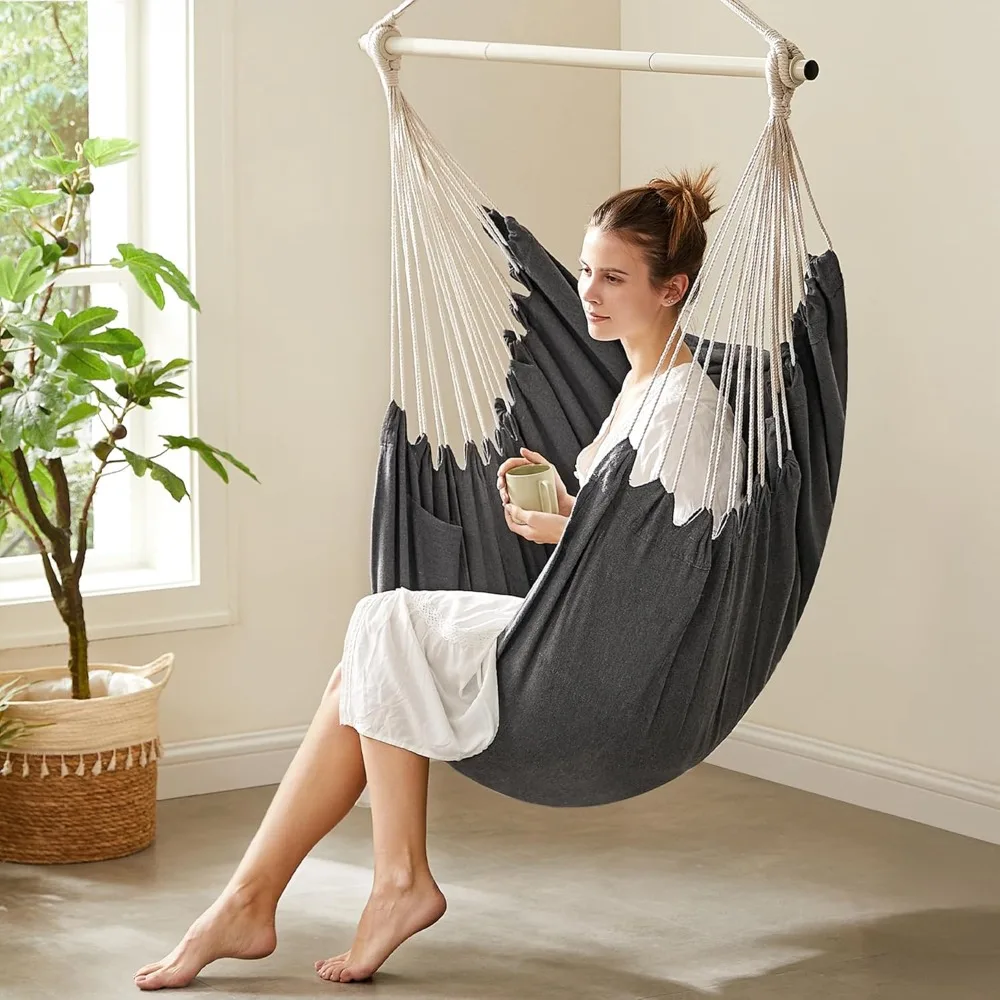
When Hammock Chair Napping Works Best: Ideal Scenarios
Hammock chairs shine in specific scenarios where short-term relaxation is the goal:
- Afternoon decompression: A 15-30 minute power nap after work or during a weekend afternoon
- Reading sessions: When enjoying a book leads to natural drowsiness
- Outdoor leisure: Gentle napping while enjoying nature’s sounds and fresh air
- Meditation transitions: Using the chair for meditation that naturally evolves into brief rest
- Small living spaces: When dedicated napping furniture isn’t practical
For optimal results:
– Limit naps to 20-30 minutes to avoid entering deeper sleep cycles
– Use the chair intentionally for relaxation rather than primary sleep
– Create a comfortable environment with proper temperature and minimal distractions
Understanding this distinction between napping and full sleep helps set appropriate expectations for your hammock chair experience. For those interested in exploring the most suitable options for longer relaxation, our guide to the most comfortable hammock types provides helpful insights.
Are Certain Hammock Chair Types Better for Napping?
Not all hammock chairs are created equal when it comes to nap comfort. Certain designs offer distinct advantages:
Design Variations That Enhance Napping Comfort
- Cocoon-style hammock chairs envelop the body more completely, providing a sense of security and better side support
- Chairs with integrated footrests allow for more natural leg positioning, reducing pressure points
- Models with extended back heights provide better head and neck support during sleep
- Wider fabric designs distribute weight more evenly and reduce pressure points
Material Considerations
- Tightly woven cotton provides breathability while maintaining support
- Quilted or padded options add cushioning for pressure points
- Weather-resistant synthetic materials work well for outdoor napping but may be less breathable
Support Structures
- Spreader bars at the top can create wider seating areas for better positioning
- Reinforced edge stitching provides better weight distribution
- Additional attachment points can improve stability during rest
For those who frequently enjoy longer relaxation sessions, our porch swing chair sets offer enhanced support features that make them more suitable for extended comfort.
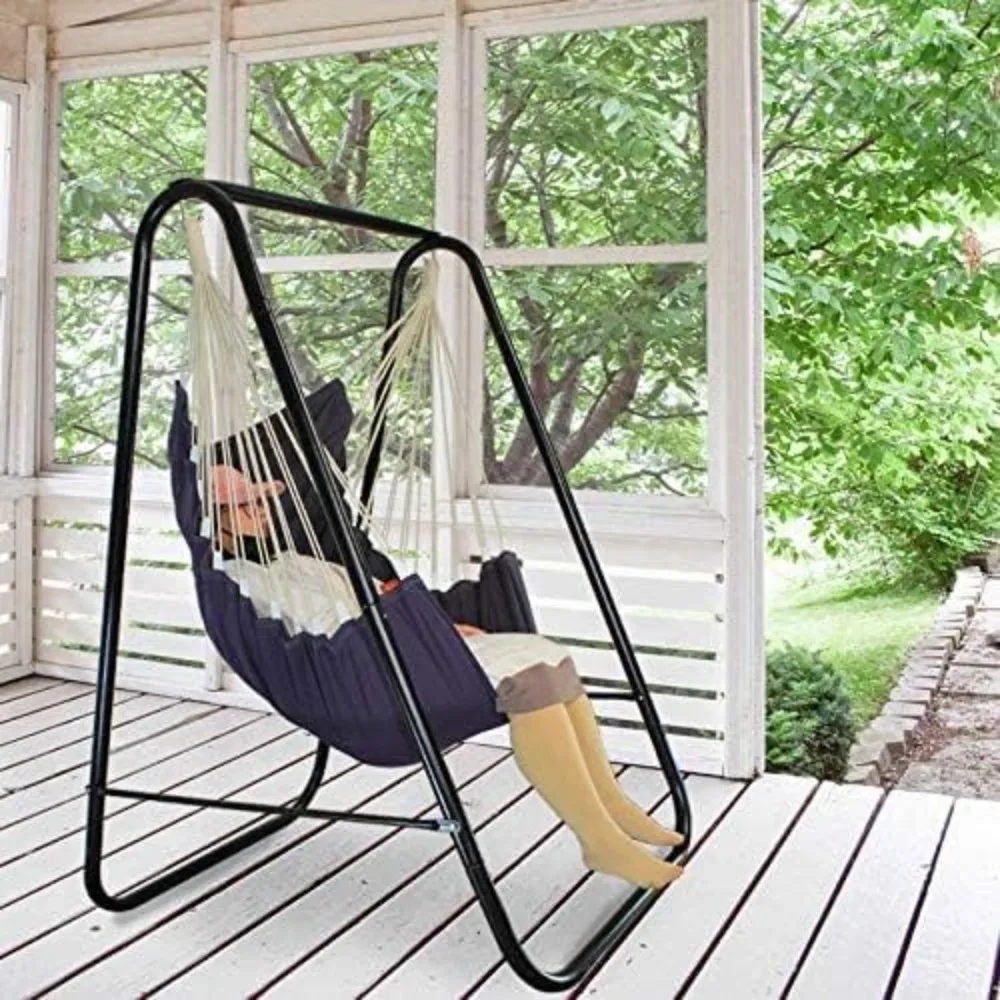
FAQs About Hammock Chair Sleeping
Is it safe to fall asleep in a hammock chair accidentally?
Generally yes, for brief periods. Occasional accidental naps in a properly installed hammock chair pose minimal risk for most healthy adults. However, ensure the chair is rated for your weight and securely installed to prevent falls.
Can children safely nap in hammock chairs?
Children should always be supervised in hammock chairs, particularly when sleeping. The design presents potential entanglement or fall hazards for young children. For older children, brief supervised naps may be acceptable with proper positioning and support.
How long is too long to sleep in a hammock chair?
Most people begin experiencing discomfort after 30-60 minutes in a hammock chair due to pressure points and less-than-ideal positioning. Limiting naps to under 30 minutes is generally recommended for comfort and to avoid neck or back strain.
Do weather conditions affect hammock chair sleeping comfort?
Absolutely. For outdoor hammock chairs, temperature, humidity, and wind can significantly impact comfort. Cold weather may cause muscle tensing, while extreme heat might cause excessive sweating against non-breathable fabrics. Always consider weather protection for outdoor napping.
How much weight can hammock chairs typically support for sleeping?
Most quality hammock chairs support between 250-350 pounds, though premium models may handle up to 500 pounds. However, weight capacity for active sitting is different than for sleeping, as sleeping involves different movement patterns. Always check manufacturer specifications and maintain a margin of safety below the maximum rating.

